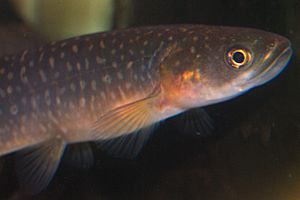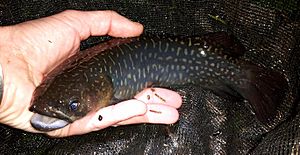Giant kōkopu facts for kids
Quick facts for kids Giant kōkopu |
|
|---|---|
 |
|
| Conservation status | |
 Gradual Decline (NZ TCS) |
|
| Scientific classification | |
| Genus: |
Galaxias
|
| Species: |
argenteus
|
The giant kōkopu (Galaxias argenteus) is a special type of fish found only in New Zealand. It is a threatened species, meaning its numbers are getting smaller. This fish can grow very large, up to 58 cm (about 23 inches) long. It can also weigh up to 2.7 kg (about 6 pounds). This makes it the biggest fish in its family, the Galaxiidae.
Giant kōkopu usually live in low-lying areas. You can find them in slow-moving streams, wet areas like wetlands, lakes, and lagoons. Most giant kōkopu have a unique life cycle. Their babies go to the sea soon after hatching. They return to fresh water about four months later as small fish, around 4.5-5 cm long. Young giant kōkopu are sometimes caught as part of the yearly whitebait catch.
Contents
What's in a Name?
The giant kōkopu was the first fish in the Galaxiidae family that scientists described. In 1789, a scientist named Johann Friedrich Gmelin first thought it was a type of pike. But later, in 1816, Georges Cuvier realized it was not a pike. He gave it the name Galaxias. This name comes from the word "galaxy" because the fish has star-like markings on its body. Over time, many other fish species were added to the Galaxias group. However, most of these other species do not have the star pattern.
Giant kōkopu are also known by other names. People sometimes call them "native trout" or "Māori trout." For many years, the name was spelled "kokopu." But now, "kōkopu" is used more often. The line above the 'o' is called a macron. It shows that the first 'o' sound is longer in the Te Reo Māori word.
How to Spot a Giant Kōkopu
Giant kōkopu usually grow to be about 30-40 cm (12-16 inches) long. Finding bigger ones is rare. But, as mentioned, one was recorded at 58 cm long and weighed 2.7 kg. This makes it the largest fish in the galaxiid family.
Unlike many fish, giant kōkopu do not have scales. Instead, they have thick, leathery skin. This skin is covered with a slimy layer called mucus. Their body is very wide and can look round or square from the front. They have strong, fleshy fins and a very large mouth.
Giant kōkopu are usually olive brown in color. Their color can range from almost black to a pale olive green. Adult fish have pale yellow spots, curved lines, and straight lines on their bodies. As the fish gets older, these markings become smaller and more numerous. When they are young, they start with a few vertical bars and spots along their side. As they grow, these marks get longer and then fade away. At the same time, the adult patterns start to appear.
Young giant kōkopu might look like small banded kōkopu. However, giant kōkopu do not have a silver mark behind their gills. Also, their markings never split or disappear at the top and bottom of their bodies.
Where They Live and What They Do
Adult giant kōkopu live in fresh water, mostly near the coast. Their young fish enter fresh water in the spring. They have spent about 4–6 months living in the sea.
Scientists have only seen giant kōkopu lay eggs in the wild once. This happens during autumn or winter. The eggs were found among plants along the river banks. A female giant kōkopu can lay many eggs, sometimes several thousand. The eggs develop on land for a few weeks in semi-dry conditions. Then, they hatch when the water level rises and covers them. The eggs hatch best in fresh water at about 10°C (50°F).
Even though most giant kōkopu go to the sea, some populations stay in fresh water their whole lives. This shows they can complete their life cycle without going to the ocean. They become adults when they are 2–3 years old. The oldest known giant kōkopu was 40 cm long and weighed 1.05 kg. Scientists think it was 21–27 years old.
Adult giant kōkopu like slow-moving water in streams or pools in low-lying areas. They often hide under things like overhanging plants, logs, or undercut banks. They wait there for food to pass by. They prefer water temperatures between 11°C and 15°C (52-59°F). They can live outside this range, but they are rare north of Auckland because it's too warm there.
Their diet includes insects that live in water and on land. They also eat freshwater crayfish, spiders, and sometimes other small fish. Giant kōkopu are usually active at night and move slowly.
Protecting the Giant Kōkopu
In 2014, the New Zealand Department of Conservation listed the giant kōkopu as "At Risk: Declining." This means their numbers are going down. The IUCN has also called them "Vulnerable" since 1996.
There are several reasons why their numbers are shrinking. These include:
- Draining of wetlands (wet areas are being dried out).
- Clearing out drains (which removes their habitat).
- Changes in how land is used, especially more dairy farming.
- Loss of plants along river banks.
- New fish species like trout that have been brought into New Zealand.
Good news! Giant kōkopu have been successfully bred in special tanks. This fish is also important as a traditional food. People think it could be raised for food in aquaculture farms.



